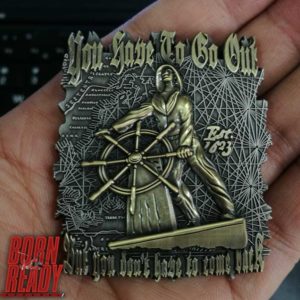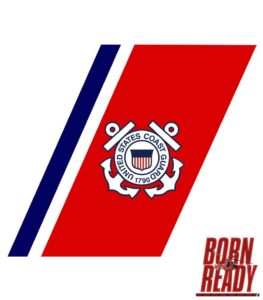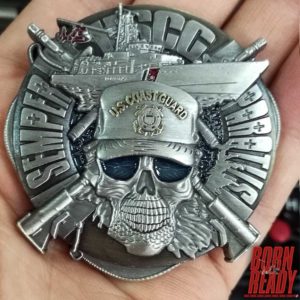From War to Waterways The Iconic Racing Stripe of the USCG is all about the United States Coast Guard (USCG) which has a long and storied history that spans back over two centuries. Throughout that time, the Coast Guard has been involved in a wide range of activities, from search and rescue missions to drug interdiction, marine environmental protection, and more. At Born Ready Apparel we honor the history and the traditions of the USCG with every Coast Guard challenge coin we design and craft.
One of the most iconic symbols of the USCG is its racing stripe, which has become synonymous with the service and its commitment to protecting the nation’s coasts and waterways. In this blog, we will explore the history of the USCG and the origins of its racing stripe.
The USCG was established on August 4, 1790, by an act of Congress. Originally called the Revenue Cutter Service, the USCG’s primary mission was to enforce federal laws relating to trade and tariffs. At the time, the United States was a young nation, and its fledgling economy relied heavily on commerce with other nations. The Revenue Cutter Service was tasked with protecting American interests by enforcing trade laws and preventing smuggling.
Over time, the USCG’s mission expanded to include search and rescue operations, marine environmental protection, and national security. Today, the Coast Guard is a multi-mission agency with over 40,000 active-duty personnel and a fleet of more than 240 cutters, boats, and aircraft. The service is responsible for patrolling over 12,000 miles of coastline and 3.4 million square miles of ocean.
One of the most recognizable symbols of the USCG is its racing stripe. The racing stripe is a wide band of orange-red that runs down the sides of most Coast Guard cutters and boats. The stripe is a visual representation of the USCG’s commitment to saving lives and protecting the nation’s waterways. The origins of the racing stripe can be traced back to World War II.
During the war, the USCG was heavily involved in escorting convoys of ships across the Atlantic Ocean. German submarines were a constant threat, and the USCG cutters were tasked with protecting the merchant ships from attack. To make the cutters more visible to other ships and aircraft, the USCG began painting them with a bright orange-red stripe.
The racing stripe served two purposes. First, it made the cutters more visible in low light conditions, such as at dawn or dusk. Second, it helped to identify the cutters as friendly ships to other vessels and aircraft. During World War II, the USCG was a key player in the Allied war effort, and the racing stripe played an important role in keeping American ships safe.
After the war, the USCG continued to use the racing stripe on its cutters and boats. Over time, the stripe became a symbol of the service’s commitment to protecting the nation’s coasts and waterways. Today, the racing stripe is an iconic symbol of the USCG, and it can be seen on everything from cutters and boats to uniforms and equipment.
In conclusion, the United States Coast Guard is a vital component of America’s maritime security infrastructure, and the racing stripe is an important symbol of the service’s commitment to protecting the nation’s waterways. The racing stripe has a rich history that dates back to World War II, and it continues to serve as a visual reminder of the USCG’s dedication to saving lives and protecting the nation’s coastlines. Whether you’re a sailor, a boater, or just someone who appreciates the role that the USCG plays in keeping America safe, the racing stripe is a powerful symbol that represents the best of what the Coast Guard stands for.




